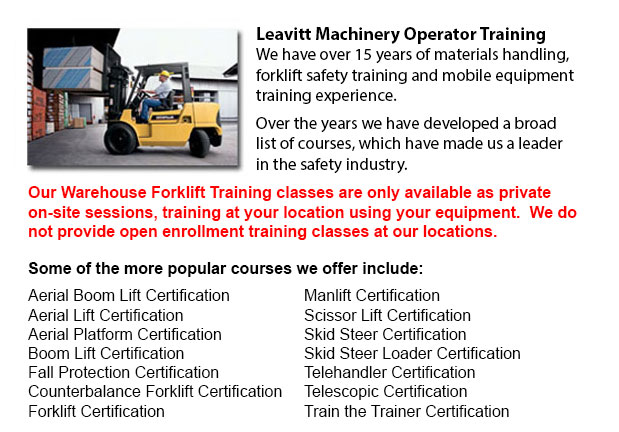
Warehouse Forklift Training Programs Fort Mcmurray - Warehouses can be industrial, commercial or retail facilities. Their function can range from product distribution to retailing bulk products. Regardless of the type of warehouse, personnel inside warehouse settings should be trained well in safety procedures related to material handling and storage, loading docks, conveyor systems, and pallet jacks and forklifts. Good housekeeping is essential to an orderly and safe warehouse setting.
Truck and loading dock systems are often situated at a height from the ground. Products exit and enter warehouses through these systems where workers unload and load materials from elevated docks and ramps. Particular attention must be paid to safety habits in this stage. To be able to avoid falls, install yellow striping along the edge of docks and ramps. Pay attention to the area all-around delivery trucks which are parked at the loading dock, particularly the area between dock and the truck. Be sure that when unloading, truck wheels are chocked.
Some warehouses use conveyor systems to distribute products inside the facility. Conveyor systems have moving belts and wheels that pose a pinch point hazard. Keep body parts and hair well away from conveyors to prevent injury. Elevated conveyors pose a hazard to workers underneath if safety nets are absent. Staff should know how to stop conveyors in the event of emergency. Be aware of the location of emergency stop buttons and off switches. When servicing conveyors, tag out/lock out measures are mandatory.
Pallet jacks and forklifts are designed to move materials around the warehouse. Forklift operators are required to take training and be given certification. Operators of pallet jacks do not require certification, but must be trained on the machinery. Training courses instruct operators in the right ways for hoisting objects and moving them to their assigned location. Neither forklifts nor pallet jacks should ever be made use of to lift or transport employees.
To allow for adequate room for equipment and people to pass, storage shelving and rack systems help to create an efficient and orderly work area, particularly if they are correctly braced. Slow and careful placement of good is needed to prevent accidents caused by products falling off the facing aisle. Aisles must be kept clear by storing products flat and within the shelving units. Pallets are used for stacking products. They must be in good condition, and palleted products must be shrink-wrapped or baled, whenever possible.
PPE or likewise referred to as personal protective equipment must be worn when required to help protect the workers' limbs, heads, hands and feet. Bump caps or hard hats, steel-toed shoes and gloves are common PPE.
Slippery floors pocked with dents and pits present a danger. Good housekeeping habits involve keeping warehouse floors and docks clear of debris, oil and dirt. The space must be kept clear of boxes, baling supplies and trash.
-
Telehandler Training Fort Mcmurray
Telehandler Training Fort Mcmurray - Telehandlers or also called Telescopic handlers are very popular piece of heavy construction equipment most often utilized in agriculture and construction industries. These machines have extreme reaching capabilit... More -
Counterbalance Forklift Training Fort Mcmurray
Counterbalance Forklift Training Fort Mcmurray - Counterbalance Forklift Training courses are always in high demand. The Counterbalance forklift is a forklift that is made along with a weight that counters the balance, evenly spreading the weight of... More -
Heavy Equipment Training School Fort Mcmurray
Heavy Equipment Training School Fort Mcmurray - HEO or the heavy equipment operator courses will provide you with the knowledge and skills required in order to enter the workforce as an entry level heavy machine operator. In this 12 week course in ad... More -
Operator Safety Training, Re-Qualification Training, In-House Instructor Training in Fort McMurray
Used in just about all boat yards, industrial construction sites or warehouse operations, the forklift is a very important component in order to help pick up and transfer supplies. The reach feature of a lift truck could help improve the applications... More -
Heavy Equipment License Fort Mcmurray
Heavy Equipment License Fort Mcmurray - A heavy equipment license can be obtained by finishing a certification and preparation course at a private training school or a vocational school. This license would qualify you to operate various types of heav... More -
Boom Lift License Fort Mcmurray
Boom Lift License Fort Mcmurray - To operate an aerial boom lift, operators must be licensed through training that can be obtained utilizing both practical training and classroom sessions and by obtaining a boom lift license. Instruction must be give... More -
Skid Steer Loader Training in Fort McMurray
A skid-steer loader is actually an engine powered machine that consists of a small and rigid frame. It is outfitted along with lift arms which are used to attach to different labor saving attachments and tools. Normally, skid-steer loaders are four-w... More -
Order Picker Ticket Fort Mcmurray
Order Picker Ticket Fort Mcmurray - Order picker's enables warehouse employees to lift pallets using forks. Likewise called a stock picker, this electrically-powered equipment is like a forklift except that an order picker is likewise utilized to lif... More

Forklift Training Fort McMurray
TOLL FREE: 1-888-254-6157
Fort McMurray, Alberta
forklifttrainingfortmcmurray.com
Email Us
About Us


